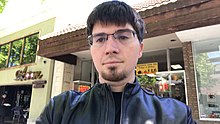Ian Goodfellow | |
|---|---|
 | |
| Born | 1987[1] |
| Nationality | American |
| Alma mater | Stanford University Université de Montréal |
| Known for | Generative adversarial networks, Adversarial examples |
| Scientific career | |
| Fields | Computer science |
| Institutions | Apple Inc. Google Brain OpenAI DeepMind Google DeepMind |
| Thesis | Deep Learning of Representations and its Application to Computer Vision (2014) |
| Doctoral advisor | Yoshua Bengio Aaron Courville |
| Website | www |
Ian J. Goodfellow (born 1987[1]) is an American computer scientist, engineer, and executive, most noted for his work on artificial neural networks and deep learning. He is a research scientist at Google DeepMind,[2] was previously employed as a research scientist at Google Brain and director of machine learning at Apple, and has made several important contributions to the field of deep learning, including the invention of the generative adversarial network (GAN). Goodfellow co-wrote, as the first author, the textbook Deep Learning (2016)[3] and wrote the chapter on deep learning in the authoritative textbook of the field of artificial intelligence, Artificial Intelligence: A Modern Approach[4][5] (used in more than 1,500 universities in 135 countries).[6]
- ^ a b "Goodfellow, Ian". Katalog der Deutschen Nationalbibliothek (in German). German National Library. Retrieved September 4, 2024.
- ^ Gurman, Mark (May 18, 2022). "Apple Executive Who Left Over Return-to-Office Policy Joins Google AI Unit". Yahoo Finance. Bloomberg News. Retrieved September 4, 2024.
- ^ Goodfellow, Ian; Bengio, Yoshua; Courville, Aaron (2016). Deep Learning. Cambridge, Massachusetts: MIT Press.
- ^ "Artificial Intelligence: A Modern Approach - The Definitive AI Book". How to Learn Machine Learning. 2020. Retrieved December 19, 2022.
- ^ Goodfellow, Ian (April 28, 2020). "Chapter 21: Deep Learning". Artificial Intelligence: A Modern Approach (PDF). By Russell, Stuart J.; Norvig, Peter (Fourth ed.). Hoboken, NJ: Pearson. ISBN 978-0134610993.
- ^ "Nobel Week Dialogue". Nobel Foundation. 2022. Retrieved December 19, 2022.